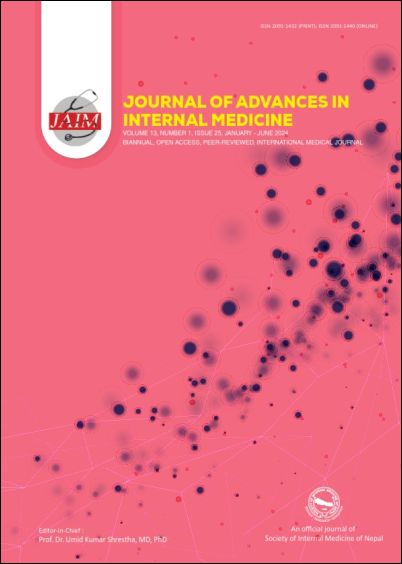Angiographic Profile of Coronary Artery Disease in Patients of Heart Failure Attending in BPKIHS, Nepal
DOI:
https://doi.org/10.3126/jaim.v13i1.68489Keywords:
Coronary Artery Disease, Heart Failure, Coronary AngiographyAbstract
INTRODUCTION Coronary Angiography in heart failure is one of the diagnostic modalities that acts as complementary tool in the management. Very few studies are conducted in Nepal regarding prevalence of CAD in HF. CAD has been one of the etiologies in 18% patients of Heart failure.1 On categorizing heart failure patients into ischemic and non-ischemic groups and knowing any anomalous anatomy would be feasible to intervene as essential and decrease in recurrent hospital admissions and improve quality of life. Our current study aimed to evaluate various characteristics and profiles of Coronary Arteries in the heart failure subjects after Coronary Angiography.
METHODS It was a single center hospital based descriptive cross-sectional study conducted at BPKIHS from October 2022 to October 2023 in heart failure patients who underwent CAG. Heart failure patients were selected based on Framingham criteria.
RESULTS Out of total 78 patients 64.15 were males and mean age was 62.4±13.69 years. There were 47.4% patients with HFrEF, 28.2% with HFmrEF and 24.4% were having HFpEF. Significant CAD was found in 70.5%, normal Coronary artery was present in 2.8%, 2.5% had anomalous coronary artery, minor CAD was found in 2.6% while 5.1% had moderate CAD. Prevalence of significant CAD was found in 70.3% patients with HFrEF, 68.2% in HFmrEF whereas HFpEF had significant CAD in 73.7% subjects. Significant CAD in males and females were 48.7% and 70.5% respectively. Smoking was the most common risk factor present in our study population. Most common presentation were Basal Lung Crepitations, Raised JVP, Hepatomegaly and Leg Swelling.
CONCLUSION Our result suggests higher prevalence of CAD in HFpEF (73.7%) followed by HFrEF (70.3%) and HFmrEF (68.2%). Coronary anomaly was seen in 2.5% while angiographic profile revealed abnormal coronary artery to be more frequent in HF subjects which was quite comparable to other similar studies of Heart failure.
Downloads
Downloads
Published
How to Cite
Issue
Section
License

This work is licensed under a Creative Commons Attribution 4.0 International License.
This license enables reusers to distribute, remix, adapt, and build upon the material in any medium or format, so long as attribution is given to the creator.




